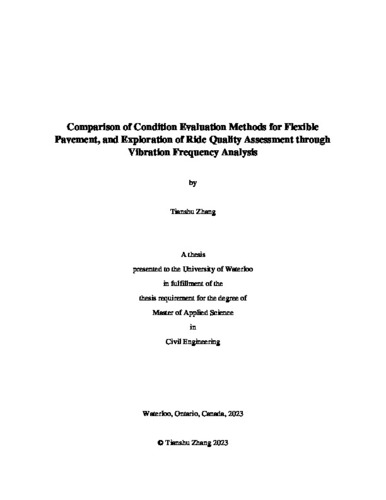| dc.contributor.author | Zhang, Tianshu | |
| dc.date.accessioned | 2023-12-12 15:51:16 (GMT) | |
| dc.date.available | 2023-12-12 15:51:16 (GMT) | |
| dc.date.issued | 2023-12-12 | |
| dc.date.submitted | 2023-12-07 | |
| dc.identifier.uri | http://hdl.handle.net/10012/20153 | |
| dc.description.abstract | This thesis reviews and compares evaluation standards, distress manifestation manuals, and key performance indices for flexible road asset management across North America. Evaluation of pavement structural and functional conditions for a road section is one of the crucial steps in determining pavement maintenance and rehabilitation strategies, as well as investment plans for road asset management. However, different evaluation methods applied to the same road section may result in notable variations of pavement condition assessments, as investigated by this study, and this often varies with different regions and road agencies. In this thesis, sixteen pavement condition rating manuals are reviewed to identify differences and similarities. A trend of simplification in the pavement evaluation process is observed in pavement rating manuals, and a potential solution involving the reduction in the types of pavement distresses, according to their manifestation correlation, is proposed.
The thesis also explores a new method for assessing ride quality through vibration frequency analysis. The evaluation processes generally consist of four components: surface distress, roughness, safety evaluation, and structural strength. Roughness, as a critical factor directly influencing the driving experience, has a close correlation with ride comfort. However, the existing pavement roughness assessment method lacks a correlation with vehicle vibration, thereby restricting its capacity to comprehensively reflect its influence on ride comfort. A car simulation model is constructed using MATLAB Simulink, and 20 road sections are tested. The simulation's vibration signals are analyzed in the frequency domain using Fast Fourier Transform (FFT). A new index, the Ride Resonance Index (RRI), is introduced based on human resonance effect evaluation in the frequency domain during driving. A moderate linear relationship is found between RRI and pavement roughness.
In summary, the diversity of evaluation methods and standards among different regions and agencies underscores the need for harmonization and simplification. The observed moderate linear relationship between RRI and International Roughness Index (IRI) suggests that it could serve as a promising supplementary indicator for evaluating pavement conditions. | en |
| dc.language.iso | en | en |
| dc.publisher | University of Waterloo | en |
| dc.subject | flexible pavement | en |
| dc.subject | pavement inspection survey | en |
| dc.subject | pavement condition evaluation | en |
| dc.subject | ride quality | en |
| dc.subject | vibration frequency evaluation | en |
| dc.title | Comparison of Condition Evaluation Methods for Flexible Pavement, and Exploration of Ride Quality Assessment through Vibration Frequency Analysis | en |
| dc.type | Master Thesis | en |
| dc.pending | false | |
| uws-etd.degree.department | Civil and Environmental Engineering | en |
| uws-etd.degree.discipline | Civil Engineering | en |
| uws-etd.degree.grantor | University of Waterloo | en |
| uws-etd.degree | Master of Applied Science | en |
| uws-etd.embargo.terms | 0 | en |
| uws.contributor.advisor | Ningyuan, Li | |
| uws.contributor.affiliation1 | Faculty of Engineering | en |
| uws.published.city | Waterloo | en |
| uws.published.country | Canada | en |
| uws.published.province | Ontario | en |
| uws.typeOfResource | Text | en |
| uws.peerReviewStatus | Unreviewed | en |
| uws.scholarLevel | Graduate | en |

